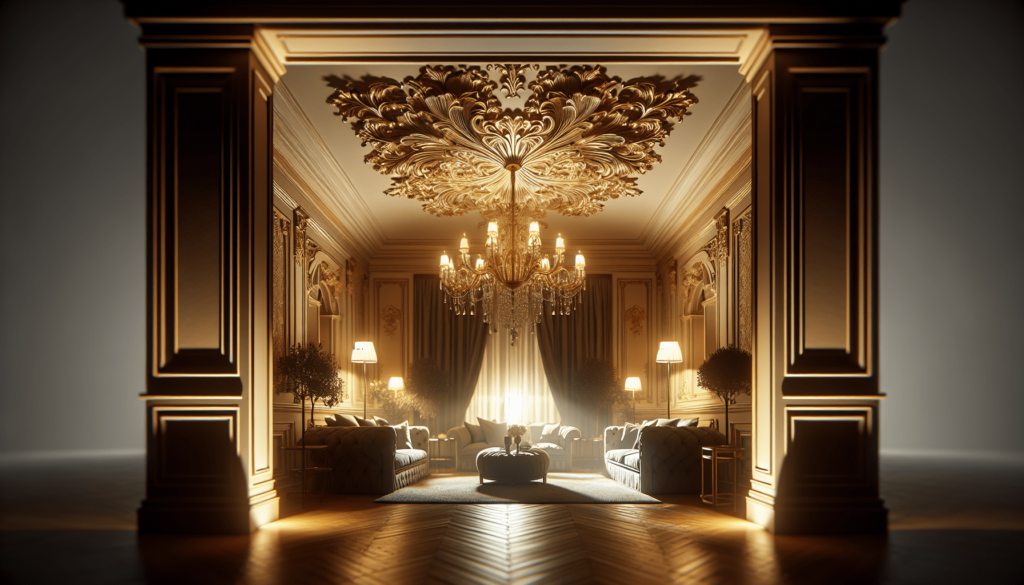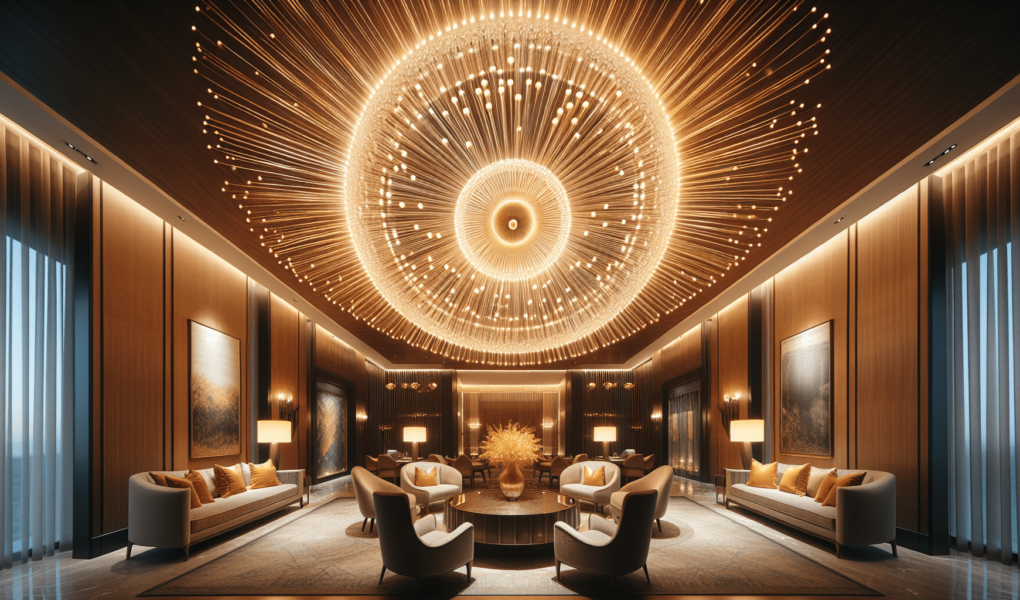Step into a world where light becomes the ultimate designer, effortlessly transforming the atmosphere of any room. In this article, you will explore the art of interior lighting schemes, a captivating journey that will leave you inspired and ready to create your own unique ambiance. Discover how the power of carefully chosen lights can illuminate every corner, enhancing your personal style and bringing life to your living space. So, buckle up and get ready to shine a light on the beauty of interior lighting schemes.

Understanding Interior Lighting
Importance of Interior Lighting
Interior lighting plays a crucial role in creating a welcoming and comfortable environment in your home. It not only illuminates the space but also enhances the overall aesthetics and functionality of the interior. Lighting has the power to transform a room, setting the mood, and creating a specific atmosphere. It can highlight architectural features, enhance colors, and even affect our mood and well-being.
Types of Interior Lighting
When it comes to interior lighting, there are several types to consider, each serving a different purpose. The three main types of interior lighting include task lighting, ambient lighting, and accent lighting. Task lighting is focused light that illuminates a specific area for performing tasks such as reading or cooking. Ambient lighting provides overall illumination to a room, creating a warm and inviting atmosphere. Accent lighting, on the other hand, is used to highlight specific features or objects, adding depth and visual interest to the space.
Choosing the Right Light Fixtures
Consider the Purpose of the Space
Before selecting light fixtures for your interior, it is essential to consider the purpose and function of the space. Different rooms have different lighting requirements. For example, a home office may require bright task lighting, while a living room may benefit from a combination of ambient and accent lighting. By understanding the purpose of each room, you can choose the right light fixtures that meet your needs.
Different Types of Light Fixtures
There are countless types of light fixtures available in the market, each with its unique style and functionality. Some common light fixtures include chandeliers, pendant lights, recessed lights, track lights, wall sconces, and floor lamps. Each type of fixture can contribute to the overall ambiance and design of the room. It is important to select fixtures that not only provide adequate lighting but also match the style and theme of your interior.
Matching the Style and Theme of the Interior
To create a cohesive and visually appealing interior, it is crucial to choose light fixtures that match the style and theme of your space. If your interior is modern and minimalistic, sleek and contemporary fixtures would be a suitable choice. On the other hand, if your home has a vintage or rustic aesthetic, you can opt for fixtures with antique or industrial designs. By carefully selecting light fixtures that complement your interior, you can create a harmonious and cohesive look.
Using Natural Light as a Design Element
In addition to artificial lighting, natural light is an important component of interior lighting. Large windows, skylights, and glass doors can allow ample natural light to flood into your space, creating a sense of openness and connection with the outdoors. Natural light not only illuminates the room but also has a positive impact on our well-being. It can help regulate our sleep-wake cycle and improve our mood. When designing your interior lighting scheme, consider the positioning of windows and doors to maximize the use of natural light.
Layering Light in the Space
Task Lighting for Specific Activities
Task lighting is essential for areas where specific activities are performed, such as reading, cooking, or working at a desk. This type of lighting provides focused and bright illumination, ensuring that you have ample light to carry out your tasks efficiently. Task lighting can be achieved through desk lamps, under-cabinet lighting in the kitchen, or adjustable spotlights.
Ambient Lighting for Overall Illumination
Ambient lighting, also known as general lighting, provides overall illumination to a room. It creates a uniform and comfortable level of light, allowing you to navigate through the space safely. Ambient lighting can be achieved through ceiling-mounted fixtures such as recessed lights or flush-mount fixtures. It can also be supplemented with floor lamps or wall sconces to create a softer and more inviting atmosphere.
Accent Lighting for Highlighting Features
Accent lighting is used to highlight specific features or objects in a room, adding depth and interest to the space. It can be used to draw attention to architectural details, artwork, or decorative elements. Accent lighting can be achieved through adjustable track lights, wall-mounted picture lights, or even candles. By strategically placing accent lights, you can create focal points and enhance the overall aesthetics of your interior.
Creating Visual Balance with Layers
The key to a well-designed lighting scheme is creating visual balance through layers of light. By combining task lighting, ambient lighting, and accent lighting, you can create a dynamic and engaging interior. Each layer of light serves a different purpose and adds depth to the space. It is important to balance the intensity and positioning of each layer to avoid harsh shadows or glare. Experiment with different combinations of light sources to find the perfect balance for your interior.
Selecting the Right Light Bulbs
Understanding Different Types of Bulbs
When selecting light bulbs, it is important to understand the different types available in the market. The most common types of bulbs include incandescent, halogen, fluorescent, and LED. Each type of bulb has its own unique characteristics in terms of energy efficiency, lifespan, color temperature, and dimming capabilities. LED bulbs have gained popularity in recent years due to their energy efficiency, long lifespan, and versatility.
Choosing the Right Color Temperature
Color temperature refers to the appearance of light produced by a bulb, ranging from warm to cool tones. It is measured in units called Kelvin (K). Warm light, typically around 2700K-3000K, creates a cozy and intimate atmosphere, suitable for bedrooms and living rooms. Cool light, around 5000K-6000K, simulates daylight and is ideal for task-oriented areas such as kitchens and workspaces. When selecting light bulbs, consider the desired mood and function of the space to choose the appropriate color temperature.
Considering Energy Efficiency and Lifespan
Energy efficiency and lifespan are important factors to consider when selecting light bulbs. LED bulbs are the most energy-efficient option, consuming significantly less electricity compared to traditional incandescent bulbs. LED bulbs also have a longer lifespan, often lasting up to 15-20 times longer than incandescent bulbs. By choosing energy-efficient bulbs, you can reduce your electricity bills and minimize the frequency of bulb replacements.

Creating a Lighting Plan
Assessing the Needs of each Room
To create an effective lighting plan, it is essential to assess the specific needs of each room in your home. Consider the activities that will be performed in each room and the desired atmosphere you want to create. A kitchen may require bright task lighting for cooking, while a bedroom may benefit from soft and relaxing lighting. Take into account the size, layout, and function of each room to determine the optimal lighting solutions.
Determining Lighting Zones
Lighting zones divide a space into different areas with specific lighting requirements. This allows for greater flexibility and customization in the way you illuminate your interior. For example, in a living room, you may have a reading zone with a floor lamp for task lighting and a conversation zone with ambient lighting. By creating lighting zones, you can easily adjust and control the lighting in each area to suit your needs.
Creating a Lighting Schedule
A lighting schedule can help automate your lighting system and create different moods throughout the day. By setting timers or using smart lighting controls, you can program your lights to turn on and off at specific times. For example, you can have soft, warm lighting in the evenings for relaxation and brighter lights in the mornings for productivity. A lighting schedule adds convenience and can enhance the overall ambiance of your space.
Considering Dimmers and Smart Lighting
Dimmers and smart lighting controls offer additional flexibility and control over your interior lighting. Dimmers allow you to adjust the brightness of your lights to create the desired mood and atmosphere. Smart lighting systems, on the other hand, offer advanced capabilities such as remote control, voice control, and integration with other smart devices. With smart lighting, you can easily customize and control your interior lighting using a smartphone app or voice commands.
Tips for Enhancing Lighting Design
Using Mirrors to Reflect Light
Mirrors can be a powerful tool in enhancing your interior lighting design. They can help amplify natural light by reflecting it into different areas of the room. Placing a mirror opposite a window can bounce light around the space, making it feel brighter and more spacious. Additionally, mirrors can also reflect artificial light, increasing its reach and impact. Consider incorporating mirrors in areas with limited natural light or in rooms that need an extra boost of brightness.
Incorporating Light Colored Surfaces
Light colored surfaces, such as walls, ceilings, and furniture, can help maximize the effects of your interior lighting. Light colors reflect more light, making a room appear brighter and more open. By choosing lighter shades for your walls and furniture, you can create a sense of airiness and spaciousness. This is particularly beneficial in rooms with limited natural light. Avoid dark and heavy color schemes that can absorb light and make a space feel smaller and gloomier.
Strategic Placement of Light Fixtures
The placement of light fixtures is crucial in achieving optimal lighting in your interior. Consider the specific areas that need illumination and position your fixtures accordingly. For example, in a kitchen, place task lighting under cabinets to illuminate countertops, and in a living room, position floor lamps near seating areas for reading or conversation. By strategically placing light fixtures, you can ensure that each area receives adequate lighting for its intended purpose.
Avoiding Glare and Shadows
Glare and shadows can negatively impact the functionality and aesthetics of your interior lighting. Glare occurs when there is excessive brightness or reflection, creating discomfort and hindering visibility. To avoid glare, use fixtures with diffusers or shades that distribute light evenly. Shadows can also be problematic, especially in task-oriented areas. To minimize shadows, ensure that light sources are positioned properly and consider combining different types of light fixtures for a more uniform and balanced illumination.

Importance of Proper Light Levels
Understanding the Concept of Foot Candles
Foot candles are a unit of measurement used to quantify the amount of light falling on a surface. It refers to the illuminance of light measured at a distance of one foot from a source. The appropriate light level varies depending on the activity or function of the space. For example, a living room may require a light level of around 10-20 foot candles, while a workspace may require 50-100 foot candles. Understanding foot candles can help ensure that your space is adequately lit for safety and comfort.
Providing Adequate Light for Safety and Comfort
Proper light levels are essential for ensuring safety and comfort in your home. Insufficient lighting can create hazards, such as tripping and falling or not being able to see potential obstacles. It can also cause eye strain and fatigue, especially in areas where tasks require visual focus. By providing adequate light levels, you can minimize the risk of accidents and enhance the overall well-being of your household members.
Creating Layered Lighting to Avoid Overexposure
While proper light levels are important, it is equally crucial to avoid overexposure to bright light. This can cause discomfort, eye strain, and headaches. By creating layered lighting, you can distribute the light more evenly and avoid excessive brightness in specific areas. Combining ambient lighting, task lighting, and accent lighting allows you to adjust the intensity of each layer to create a comfortable and balanced lighting scheme.
Integrating Lighting Controls
Manual vs. Automated Lighting Controls
Lighting controls offer a convenient way to adjust and control your interior lighting. Manual controls, such as switches and dimmers, allow you to manually adjust the brightness of your lights. Automated lighting controls, on the other hand, provide advanced features and functionalities. These systems can be programmed to turn lights on and off at specific times, adjust brightness levels automatically, and even respond to motion or voice commands. Choosing between manual and automated controls depends on your personal preference and the level of customization you desire.
Dimmers, Timers, and Motion Sensors
Dimmers, timers, and motion sensors are popular lighting control options that can enhance your overall lighting experience. Dimmers allow you to adjust the brightness of your lights, providing flexibility and the ability to create different moods. Timers can be set to turn lights on and off automatically, ensuring energy efficiency and added security. Motion sensors detect movement and can automatically turn lights on or off, providing convenience and energy savings.
Smart Lighting for Convenience and Energy Saving
Smart lighting systems take lighting control to the next level, offering a seamless and convenient way to manage your interior lighting. These systems can be controlled through smartphone apps, voice assistants, or even integrated with other smart devices in your home. With smart lighting, you can easily customize and automate your lighting based on your preferences. This not only adds convenience but also helps save energy by allowing you to fine-tune your lighting settings and schedule.

Evaluating Lighting in Different Rooms
Living Room Lighting Ideas
The living room is a multifunctional space that requires a well-designed lighting scheme. Consider incorporating a combination of ambient lighting, such as overhead fixtures or wall sconces, and task lighting, such as floor or table lamps for reading or accentuating specific areas. Use adjustable accent lighting to showcase artwork or architectural features. Create a cozy and inviting atmosphere by using warm white bulbs and incorporating dimmers for adjustable brightness.
Bedroom Lighting Ideas
The bedroom is a space for relaxation and rejuvenation. Incorporate soft and warm ambient lighting, such as bedside table lamps or wall-mounted fixtures, to create a calming atmosphere. Task lighting, such as reading lamps, should be adjustable and placed near the bed for convenience. Consider incorporating dimmers to create a soothing ambiance in the evenings. Avoid bright and harsh lighting that can disrupt sleep patterns.
Kitchen Lighting Ideas
The kitchen is a functional space that requires ample task lighting for cooking and food preparation. Install under-cabinet lighting to illuminate countertops and work areas. Consider pendant lights or track lights above the kitchen island or dining area for both functional and decorative purposes. Supplement with ambient lighting, such as recessed lights, to provide overall illumination. Choose bulbs with cool color temperatures to simulate daylight and enhance visibility.
Bathroom Lighting Ideas
The bathroom is a space that requires a combination of task lighting and ambient lighting. Task lighting should be placed around the vanity area for grooming and makeup application. Use sconces or vertical fixtures on either side of the mirror to minimize shadows on the face. Supplement with overhead ambient lighting to provide overall illumination. Consider incorporating dimmers for adjusting brightness and creating a spa-like ambiance.
Trends in Interior Lighting
LED Lighting and Its Advantages
LED lighting has become increasingly popular in recent years due to its numerous advantages. LED bulbs are energy-efficient, consuming significantly less electricity compared to traditional incandescent bulbs. They also have a longer lifespan, reducing the frequency of bulb replacements. LED bulbs are available in various color temperatures and can be dimmable, offering flexibility in creating the desired ambiance. Furthermore, LED technology allows for compact and versatile designs that can be integrated into various light fixtures.
Wireless Lighting Systems
Wireless lighting systems offer a convenient and flexible way to control and automate your interior lighting. These systems eliminate the need for complex wiring and allow for easy installation and customization. Wireless lighting systems can be controlled through smartphones or voice assistants, offering seamless integration with other smart devices. They also provide the option to adjust brightness levels, create schedules, and even change colors, allowing for endless possibilities in lighting design.
Sustainable and Eco-Friendly Lighting Solutions
As environmental consciousness continues to grow, sustainable and eco-friendly lighting solutions are gaining popularity. Energy-efficient LED bulbs contribute to reduced energy consumption and lower carbon emissions. Additionally, eco-friendly lighting fixtures are made from recycled or recyclable materials, minimizing waste and the environmental impact. By opting for sustainable lighting solutions, you can not only reduce your carbon footprint but also create a healthier and more environmentally conscious home.
In conclusion, understanding interior lighting is crucial for creating a welcoming and functional space. By considering the purpose of each room, choosing the right light fixtures, layering light, selecting the appropriate light bulbs, creating a lighting plan, and incorporating lighting controls, you can achieve a well-designed and customized lighting scheme that enhances your interior. By following these tips, you can transform your home into a beautifully illuminated haven that perfectly suits your needs and aesthetic preferences.



